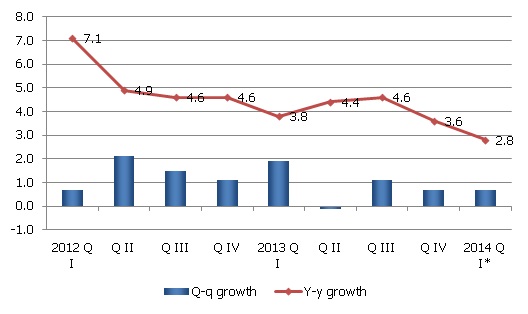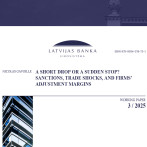Despite weaker retail trade and industry growth, the economy growing at a stable rate
According to the flash estimate published by the Central Statistical Bureau, gross domestic product (GDP) in the first quarter of 2014 grew by 0.7% quarter-on-quarter (seasonal effects excluded). A similar growth rate was observed in the previous quarter as well. Year-on-year, GDP grew by 2.8%. We had previously predicted that in the first quarter of 2014, activity in retail trade could be slightly lower in relation to the euro introduction on the consumer and behaviour of traders. These predictions came true and this earlier effect had an impact on the retail trade indicator, which dropped by 0.4% in the first quarter (more detailed analysis in my colleague's commentary on retail trade).
At the same time, in the first quarter several branches posted unexpected results. In January, there was a "shock" in the manufacturing data, which had a substantial effect on the quarterly indicators of the branch – quarter-on-quarter, output volumes dropped by 5.6%. A negative impact on the GDP development was left by the energy sector – last winter was uncharacteristically warm, resulting in heat-electric generating plants and other cogeneration stations being operated less than usual and the output in this branch dropped by 3.4%.
There were also positive surprises. First, it was the transport branch, ports, to be exact. The data of cargo handled for the first quarter are very good, particularly at the Riga free port. Growth has been observed in most groups of goods, but particularly rapid was the growth in the flow of oil products through the Riga free port. It can possibly be explained by problems at the Mažeiķi oil processing plant, which resulted in a greater flow of Russian oil products ending up at the Riga free port. As a result of the warm weather conditions, construction workers report that they managed to work more than usual in the winter months, thus, in all likelihood, in the construction branch also we can expect a substantial rise in the first quarter. Other service branches, including public utilities, have also posted stable growth in recent quarters. That seems to indicate that, in keeping with the predictions, it is service branches which at the beginning of the year helped to maintain GDP growth.
There are no great new developments with regard to the countries of the European Union (EU): the economies are continuing to grow in about the same manner as previously projected. A gradual recovery of the real economy is continuing, but the fiscal and labour market position remains weak in many countries.
Continued recovery of the economies of the EU countries will allow Latvian manufacturers to raise their export volumes. Yet the main new development externally is of course related to the escalation in the conflict between Ukraine and Russia. At the moment, there are no macroeconomic signs that would indicate that the Latvian economy is already suffering from the effects of the above geopolitical situation. Moreover, the confidence indicators aggregated by the European Commission were once again on the rise in April after a drop in March.
Yet, in all likelihood, the economy will be more or less affected in the coming quarters. Some manufacturers and service providers are already admitting to observing certain problems, which, however, are mostly related to confidence effects and the unfavourable trend in the rouble exchange rate. It is the confidence effects, i.e. the confidence in the future of participants in the economy that will determine the future growth of the economy. Confidence in the future is particularly important for businessmen in making new investment decisions or households in choosing to make larger purchases.
Taking into account the first quarter indicators and potential negative effects from the escalation of the geopolitical situation, it is possible that GDP growth this year could be slightly weaker than previously projected. Yet it must be emphasized that if the geopolitical situation does not deteriorate any further, the impact of this conflict on the Latvian economy could be limited both in terms of scale and time.
The full extent of the GDP scan will be published on 9 June.
Illustration. GDP growth (q-o-q, seasonally adjusted data at constant prices)

Source: CSB
* CSB flash estimate
Textual error
«… …»






